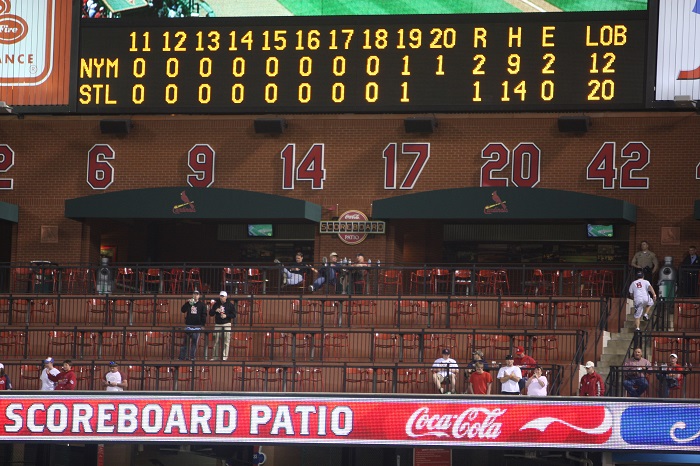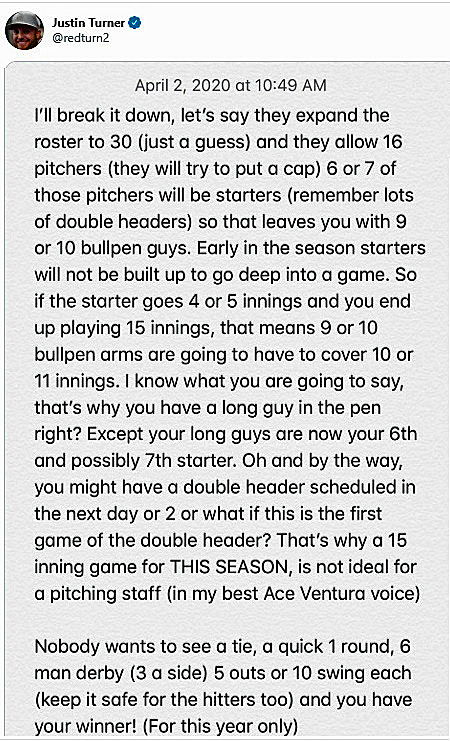I am an unabashed, old-school baseball purist. For me, the game was best when:
- Starting pitchers were expected to complete games and hit for themselves.
- A relief pitcher, when needed, was expected to pitch multiple innings.
- Catchers were expected to block the plate to prevent runners from scoring.
- Runners trying to score were expected to plow through catchers to try to knock the ball loose.
- Pitchers would knock down – or even hit – opposing batters in retaliation for sign-stealing or other antics deemed inappropriate (à la the Joe Kelly Fight Club).
- Runners were expected to run hard to first base and use take-out slides at second base to break up double plays.
- The teams with the best regular season records from the National and American Leagues played each other in the World Series.
Obviously, changes have been made to the great game of baseball over the years, not all for the best, and more are coming. It will not be long until the designated hitter rule is implemented in the National League. To improve the pace-of-play, MLB and the Players Association have agreed to changes that are being tested in Independent Leagues, and Minor League Baseball, including ways to shorten extra-inning games. Currently, minor league teams begin each extra inning with the player who made the final out (or a pinch-runner) in the ninth and each subsequent extra inning automatically being placed on second base and the inning will then proceed as normal.
(Note: The runner automatically placed on second base is officially scored as having reached on an unassigned error so that the pitcher is not charged with an earned run should that runner scores).

Recently, Dodgers third baseman Justin Turner proposed another method to decide extra-inning games – a home run contest with each team selecting three players to participate. Certainly out-of-the-box thinking that would undoubtedly be popular with fans of teams with several sluggers on their roster … say, like, the Dodgers and Yankees.

Is it time for MLB to consider adding ties to regular season games? Vin Scully would have a conniption. Purists would shout blasphemy. But there would be benefits to pace-of-play, and team pitching staffs. Teams could play an extra inning, or two before a game would officially end as a tie, with each team being credited with a half win, and a half loss. Over the course of a 162-game season there would be very little, if any, difference to the final standings by including ties.
As a baseball purist, I do not care for a game being determined by a home run derby or by placing runners at second base to start each extra inning. But neither do I enjoy extra-inning games that go beyond an inning or two.
Perhaps it is time to consider ties for regular season games only.
What do you think, Dodgers fans?
* * * * * *




 April 27th, 2020 at 8:00 am
April 27th, 2020 at 8:00 am  by 0799291000348
by 0799291000348  Posted in
Posted in 

From 2011 through 2016 there were 14,577 regular season games played, and only 1301 (9%) went extra innings. 2/3 of the extra inning games were decided in either the 10th or 11th innings. Those games are not the problem, it is the games that extend from 12 to 16+ innings. I would not mind seeing games extra inning games for two (or perhaps three) innings, and if no winner then game is declared a draw.
As. much as I love Justin Turner, his idea would echo the Shootout in hockey which I hate.
@Dodgers Some type of tiebreaker, don’t have a strong preference. With 162 games I don’t see the need… https://t.co/dYsfVaBZ9G
I’m ok with tie games for this season due to what is likely to be a compressed schedule. Let’s save the pitching staffs from the extensive extra-inning games that I like to call unscheduled doubleheaders. After 12 or 13 innings call it a tie.
I don’t like a win by a HR derby or starting with a runner on second base,the game was played through 9 innings as baseball is always played, now we want to play HR derby with a pitcher ( most likely a coach ) trying to throw a ball right were the batter wants the ball pitched, or a runner starts on second base to start the extra inning. Let’s make the 10 inning different and exciting.I would start the 10 inning with the regular scheduled batter and he will be followed by the next 8 batters or pinch hitters.There is no outs, only 9 batters and see how many runs they can score, no outs counted so stolen base attempts, bunts, pinch hitters, strategy,could be fun to play and watch.As I said no outs are counted but the game can end before the home team sends up nine batters if they score more runs than the visiting team or can’t get as many runs as the visiting team has with the remaining batters they have. In case the game is still tied after the inning is over than the team with the most total bases is the winner.Just another idea.
I like the out-of-box thinking. Innovative, and fans should enjoy
How bout a coin toss; best two out of three? (Yes, I’m kidding … sort of).
Rock-paper-scissors by the two managers; cameras focus on their hands and displayed on the Jumbotron; umpire crew chief count is blasted on stadium speakers with appropriate music blaring in the background. Baseball at its best! That’s what 4 weeks of quarantine has done to me!
No trash cans permitted in the dugouts, of course.
They can only “Bang the Drum Slowly.”
I agree it is important to remember that baseball has been changed over the years. Some people probably think baseball should never change. But it should evolve like every sport.